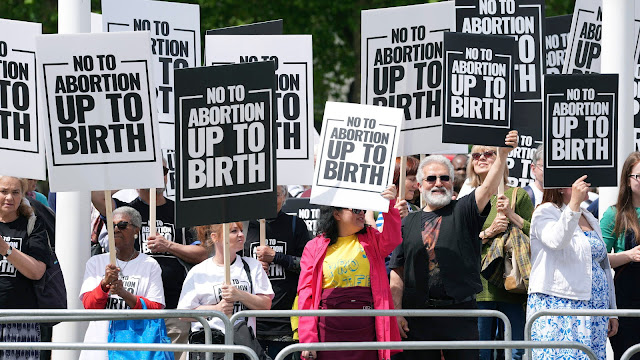British Ban on Protesting Outside Abortion Clinics: A New Chapter for Public Order in the UK
On Thursday, a groundbreaking new law came into effect in England and Wales, aiming to safeguard women accessing abortion services from the influence and interference of protesters. This legislation, falling under the Public Order Act, establishes 150-meter “protected zones” around abortion clinics, effectively banning protests that could hinder or intimidate individuals seeking abortion care. This British ban, which offers an unprecedented level of protection in this sensitive area, has sparked significant discussions about the balance between free expression and the right to healthcare.
The Law and its Implications for Abortion Clinics
The law’s core objective is to ensure that anyone seeking an abortion can do so without facing intimidation or undue influence. Within the 150-meter buffer zones, any actions deemed obstructive, intimidating, or exerting pressure on individuals entering clinics are explicitly prohibited. This ban is broad enough to encompass traditional protest actions, like chanting or holding up signs. However, it also leaves room for interpretation in the case of silent acts, such as praying or standing in the vicinity of the clinic, which could still influence visitors but do not overtly disrupt clinic operations.
The legislation’s introduction follows extensive debate and a protracted implementation process, including an 18-month delay as policymakers weighed amendments. One of the most contentious points has been whether silent prayer or passive presence within the zones should be permitted. The law’s lack of clarity on this front has already led legal experts to predict that courts may ultimately need to settle the matter.
The legislation’s introduction follows extensive debate and a protracted implementation process, including an 18-month delay as policymakers weighed amendments. One of the most contentious points has been whether silent prayer or passive presence within the zones should be permitted. The law’s lack of clarity on this front has already led legal experts to predict that courts may ultimately need to settle the matter.
Silent Prayer: Freedom of Expression or Intimidation?
Silent prayer has emerged as a particularly complex aspect of the new legislation. Some proponents argue that silent prayer is a harmless form of expression, while others see it as a subtle yet potent means of influence. The Crown Prosecution Service (CPS) clarified that silent prayer in itself is not inherently illegal but instead falls within the police’s discretion. This has effectively left law enforcement with the difficult task of interpreting and enforcing the law based on the circumstances of each incident, a situation that could lead to future legal challenges.
Louise McCudden of MSI Reproductive Choices argues that any prayer, silent or otherwise, outside an abortion clinic inherently seeks to exert control over women’s decisions. This view reflects the stance of many pro-choice advocates who believe that even seemingly passive acts, like silent prayer, can contribute to an environment that feels judgmental or intimidating. Conversely, Bishop John Sherrington of the Catholic Bishops' Conference of England and Wales contends that the law unfairly restricts individuals’ right to publicly express religious beliefs and conduct charitable acts. The two perspectives underscore the fundamental challenge of balancing freedom of expression with the need to create safe, neutral spaces around healthcare facilities.
Comparisons to International Approaches on Abortion Rights
The UK’s approach contrasts significantly with that of the United States, where abortion rights have become increasingly restricted in recent years, especially following the overturning of Roe v. Wade. While the new British law expands protections for women seeking abortions, recent shifts in U.S. law have led to widespread reductions in abortion access, with many states enacting restrictive measures on both abortion providers and women seeking the procedure.
The UK's 1967 Abortion Act generally allows abortions up to 24 weeks, contingent upon a doctor's approval. However, this new legislation raises the stakes for anti-abortion advocates, as any form of disruptive protest could incur serious consequences, including steep fines with no specified maximum. This harsher stance represents an attempt to prevent the kind of aggressive, sometimes confrontational activism that can create hostile environments for clinic patients.
The UK's 1967 Abortion Act generally allows abortions up to 24 weeks, contingent upon a doctor's approval. However, this new legislation raises the stakes for anti-abortion advocates, as any form of disruptive protest could incur serious consequences, including steep fines with no specified maximum. This harsher stance represents an attempt to prevent the kind of aggressive, sometimes confrontational activism that can create hostile environments for clinic patients.
A Balancing Act: Public Reaction and Legal Debate
The British public’s reaction to the new law has been mixed, highlighting the divergent views within the country. Supporters argue that it addresses a pressing need for safe access to healthcare without fear of judgment or harassment. Crime and Policing Minister Diana Johnson has expressed confidence that the measures will indeed protect women who rely on these healthcare services, a sentiment echoed by many reproductive rights advocates who see this as a necessary step toward safeguarding personal health decisions.|
However, the Catholic Bishops' Conference has raised ethical concerns, suggesting that the law encroaches on religious freedoms. For them, the legislation’s broad reach, especially in regard to silent forms of protest, limits individual rights to publicly express religious beliefs and engage in charitable actions, even if these acts are intended to be peaceful.
This disagreement over the interpretation and enforcement of the law has left legal experts anticipating that future court cases may provide further clarity. For now, the responsibility largely falls to law enforcement agencies, which must navigate the nuanced boundary between free expression and disruptive influence.
However, the Catholic Bishops' Conference has raised ethical concerns, suggesting that the law encroaches on religious freedoms. For them, the legislation’s broad reach, especially in regard to silent forms of protest, limits individual rights to publicly express religious beliefs and engage in charitable actions, even if these acts are intended to be peaceful.
This disagreement over the interpretation and enforcement of the law has left legal experts anticipating that future court cases may provide further clarity. For now, the responsibility largely falls to law enforcement agencies, which must navigate the nuanced boundary between free expression and disruptive influence.
The Future of Protected Zones Around Abortion Clinics
As this law goes into effect, it symbolizes a significant step toward enhancing abortion clinic security and addressing concerns about patient privacy and comfort. While the ban provides clear boundaries around overt protests, the ongoing debate around passive protest activities, such as silent prayer, will likely shape future policies and legal precedents. Whether this legislation sets a precedent for further restrictions around sensitive healthcare facilities or undergoes adjustments to address religious freedoms remains to be seen.
In its current form, the law reflects a distinctive approach to public order, one that prioritizes patient protection while wrestling with complex questions of free expression and religious practice. As Britain moves forward, the outcome of legal challenges, enforcement decisions, and public reactions will provide insights into how societies can best navigate the intersection of personal beliefs and public welfare. For now, the protected zones stand as a notable development in the ongoing discussion about abortion rights, healthcare access, and the freedoms that define democratic societies.
In its current form, the law reflects a distinctive approach to public order, one that prioritizes patient protection while wrestling with complex questions of free expression and religious practice. As Britain moves forward, the outcome of legal challenges, enforcement decisions, and public reactions will provide insights into how societies can best navigate the intersection of personal beliefs and public welfare. For now, the protected zones stand as a notable development in the ongoing discussion about abortion rights, healthcare access, and the freedoms that define democratic societies.



Comments
Post a Comment